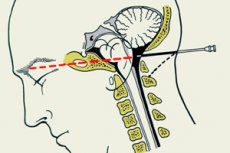Medical expert of the article
New publications
Cervical (suboccipital) puncture
Last reviewed: 07.07.2025

All iLive content is medically reviewed or fact checked to ensure as much factual accuracy as possible.
We have strict sourcing guidelines and only link to reputable media sites, academic research institutions and, whenever possible, medically peer reviewed studies. Note that the numbers in parentheses ([1], [2], etc.) are clickable links to these studies.
If you feel that any of our content is inaccurate, out-of-date, or otherwise questionable, please select it and press Ctrl + Enter.

Cervical or suboccipital puncture can be used in the presence of contraindications to conventional lumbar puncture (for example, in case of an infectious process in the lumbar region).
Complications
Lumbar puncture very rarely causes serious complications. Transient dysfunctions, on the contrary, are quite common. According to various data, post-puncture headache occurs in 1-3 out of 10 patients. The pain is usually localized in the frontal region and, as a rule, disappears in a lying position. Neck pain is often observed. Sometimes, nausea, vomiting, tinnitus, ear congestion, and cold sweat also occur in an upright position. Pain can occur as early as 15 minutes, sometimes after 4 days, but more often within 12-24 hours after the puncture. Postural headache usually lasts 4-7 days, but can pass earlier or remain for 2 weeks. Apparently, the headache occurs due to tension of the pain-sensitive meninges and vessels, due to the outflow of cerebrospinal fluid through the puncture hole in the dura mater of the spinal cord and the development of cerebrospinal fluid hypotension. Headaches occur much more frequently after using thick or blunt puncture needles. When using very thin needles, post-puncture headaches occur very rarely, although fluid collection in this case is very delayed. Since post-puncture headaches are caused by intracranial hypotension, treatment is limited to bed rest, oral hydration (2-4 l per day), and subcutaneous or intramuscular administration of 400-600 mg of sodium caffeine benzoate.
Local back pain may be due to nerve root irritation, periosteal trauma, local blood or fluid collection, mild annular injury, or true disc herniation. Infection, an extremely rare complication of lumbar puncture, is a consequence of aseptic failure or occurs when the needle passes through infected tissue. Meningitis may occur within 12 hours of puncture. Less acute infections, such as epidural abscess or vertebral body osteomyelitis, are equally rare. The most serious complications of puncture are tentorial and cerebellar herniations. Herniation occurs when cerebrospinal fluid circulation is blocked, preventing rapid equalization of pressure differences in the subarachnoid space when cerebrospinal fluid is removed. The risk of herniation is especially high in cases of space-occupying processes in the posterior cranial fossa. Although local moderate bleeding during puncture is unnoticeable, it may cause difficulties in interpreting the results of subsequent puncture due to residual xanthochromia. Spinal subdural hematoma compressing the equine tail is one of the rarest complications of puncture. Unreasonable difficulties in interpretation are caused by another casuistic complication of puncture - diplopia associated with damage to the abducens nerve (IV) as a result of its tension over the bony formations of the skull base, since the outflow of fluid from the lumbar cistern displaces the intracranial structures downward and posteriorly. The most unusual late complication is the formation of a dermoid tumor in the subarachnoid space from epidermal cells introduced during the puncture.
What do need to examine?
What tests are needed?


 [
[